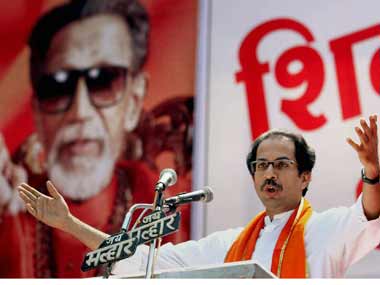The crunch moment has come. Shiv Sena has to decide, finally, if it wants to stay afloat on its own, rebuild itself as a counter to the Bharatiya Janata Party, or lose its all — the image of a no-nonsense party of the past, and a future of some worth for itself. Hark back to the way the Sena, especially its leaders, the late Bal Thackeray, then Uddhav Thackeray, and even breakaway cousin Raj Thackeray often saying that they can ensure compliance on public issues “in our Sena style”. That bravura did not include knuckling down even to its partner, the Bharatiya Janata Party. [caption id=“attachment_1772317” align=“alignleft” width=“380”]  Shiv Sena chief Uddhav Thackeray. PTI[/caption] That characteristic ‘my way or the highway’ that Uddhav Thackeray brought to the fore was when he asked the BJP to take a walk on the issue of seat sharing, though that audacity was mired in the fear that if it parted with more seats, the party, post-Narendra Modi, would lose clout, including a chief ministership. It was an error from which all his subsequent woes have built up, one upon the other, though he did far better than one hoped for, winning the number of seats he did for the party single-handedly. That raises his stock within the party. Now, by agreeing to a smaller role, by supporting the BJP’s government formation, he may lose all that. The party’s known swagger, seen in the pronouncements of the leaders, and the way the cader walks the street, may become vacuous. It would lose respect. The Sena had been a big brother right from when the two parties worked out their relationship in 1989 for electoral politics. It cannot easily morph into a submissive smaller partner without the co-equal of a deputy chief minister as a counterweight to the BJP’s CM. Of course, the Constitution does not speak of a deputy CM. It is unlikely that its pre-poll choice to not continue with the old ally was a consensus among the top leaders. The tradition in the party is to consult, if at all and the leader makes his choice, even contrary to any counsel. It was done despite the writing on the wall that had they worked together, the government was theirs, except for the minor detail if which party got its candidate to head it. It was entirely Uddhav Thackeray’s call to not climb down even a whit to BJP’s demands — equal number of seats, 18 assigned to the smaller allies, the latter also a sticking point. In retrospect, it needn’t have been. Only one from the smaller partners won. But in electoral politics, which is also a gamble, there is always a set of ‘could haves’. Now reports suggest a split view in the Sena, if not just within the top tiers of the Sena but also widely among the cadre that it should not opt for a remarriage with the BJP. The impending status of ‘younger brother’ seems to worry the party’s rank and file. The top tier may worry about power and pelf. On the street, where it matters, the view is without a deputy chief minister and major portfolios the the entire dynamics of the party would be altered. A drastic scaling down of its involvement in the power structure would mean the swagger is lost forever. Reworking a stronger position for itself by being within the government would be tougher. This alternative perspective stresses staying out of the government as resolutely as Uddhav Thackeray spurned the BJP terms. It should opt for the opposition role, and when both Congress and the NCP are down and out, fill the opposition space, and hope to become a government-in-waiting. There is much merit in this. NCP’s outside support implies some hidden sweetheart deals, what with the several scams waiting to be probed. If NCP wanted to firewall itself, the Sena should try to bring the BJP’s minority government to walk the talk on corruption. Only by being in the opposition could the Sena could go hammer and tongs and build for itself a constituency. Being in the government does not so eminently serve the Sena’s long-term purpose. The credit would go the BJP’s way. Sena’s plank then could be BJP’s opportunism, of its dependence on the NCP after calling it names. It is better that way for it than be mocked by others for seeking to again sup with BJP by inviting itself to the table. It has the other task of trying to win over the Maharashtra Navnirman Sena cadres to its fold. As the single largest party, the BJP is unlikely, given the aggression and meticulous planning of Amit Shah and Narendra Modi, let any space for the Sena. It has to be wrested from outside, not as a partner. By joining the government, it weakens itself and be seen as having bowed to scrape the floor. No doubt the Sena risks losing its hold on several local bodies, including major cities. It is a risk worth taking because, by some rearranging in its ethics, the Sena can improve conditions in such places and hope to retain the control and the benefits thereof. It has to be ready for the long haul. Or “the Sena’s way” would sound so empty.
Shiv Sena should opt for opposition role, and when both Congress and NCP are down and out, fill opposition space and hope to become a government-in-waiting.
Advertisement
End of Article
Written by Mahesh Vijapurkar
Mahesh Vijapurkar likes to take a worm’s eye-view of issues – that is, from the common man’s perspective. He was a journalist with The Indian Express and then The Hindu and now potters around with human development and urban issues. see more


)
)
)
)
)
)
)
)
)



